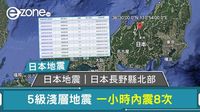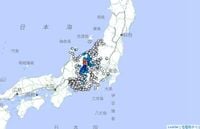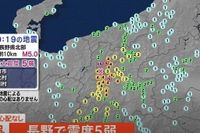On April 18, 2025, at approximately 8:19 PM local time, a magnitude 5.0 earthquake struck northern Nagano Prefecture in Japan. The Japan Meteorological Agency (JMA) reported that the earthquake had a hypocenter depth of just 10 kilometers, which is relatively shallow and can often lead to stronger surface shaking.
The strongest tremors were recorded at a seismic intensity of 5 lower on the Japanese scale, felt primarily in Omachi City, Chikuhoku Village, and Ogawa Village. In addition, tremors of intensity 4 were experienced in several other locations, including Nagano City, Matsumoto City, Azumino City, Aokimura, Asahi Village, Ikusaka Village, Ikeda Town, and Matsukawa Village. Tremors of intensity 3 were also felt in areas such as Ueda City, Saku City, Komoro City, and several others.
Fortunately, as of now, there have been no reports of casualties or significant damage resulting from the quake. Local authorities and the JMA have assured residents that there is no risk of a tsunami following the earthquake. This observation is particularly significant as it marks the first time since the Noto Peninsula earthquake on January 1, 2024, that Nagano Prefecture has experienced a tremor of this magnitude.
The earthquake occurred in a region that is no stranger to seismic activity, given Japan's location along the Pacific Ring of Fire, where tectonic plates frequently shift. However, the relatively shallow depth of this quake raised concerns about potential damage, especially in densely populated areas.
In the immediate aftermath of the earthquake, the Japanese Prime Minister's Office issued an 'Emergency Earthquake Alert,' warning residents in the Shinano region to be prepared for strong aftershocks. This alert system is crucial in Japan, where earthquakes are a common occurrence, and it serves to inform the public promptly in the event of seismic activity.
Residents in the affected areas expressed their relief at the lack of serious consequences from the earthquake. Many took to social media to share their experiences, noting the suddenness of the tremors and the brief moments of panic that followed. One resident from Omachi City remarked, "It was quite a shock, but I’m glad everyone is safe."
Experts from the JMA and local universities are closely monitoring the situation, analyzing data to understand the earthquake's implications and to prepare for any aftershocks that may occur. Professor Takashi Nishimura, a seismologist at Nagano University, explained, "While the earthquake itself was not catastrophic, we must remain vigilant as aftershocks can sometimes be stronger than the initial quake. Our monitoring systems are designed to detect these events quickly and efficiently."
Japan has a comprehensive earthquake preparedness system in place, which includes strict building codes designed to withstand seismic activity. In addition, regular drills and public education campaigns aim to ensure that residents know how to respond in the event of an earthquake. However, despite these measures, the psychological impact of earthquakes can be significant, leading to anxiety and fear among the population.
As the evening unfolded, emergency services conducted checks in the most affected areas to ensure that infrastructure remained intact and that residents were safe. The JMA continues to provide updates, urging people to remain cautious and to report any damage or injuries immediately.
In a country where earthquakes are a part of life, this event serves as a reminder of the importance of preparedness and resilience. The quick response from local authorities and the absence of serious consequences highlight the effectiveness of Japan's earthquake readiness strategies. As experts continue to study the incident, communities are left to reflect on the experience and prepare for whatever may come next.
In conclusion, while the earthquake in Nagano Prefecture was significant enough to warrant attention, the lack of damage or casualties is a testament to Japan's robust emergency management systems and the preparedness of its citizens. As the region returns to normalcy, the focus will shift to monitoring for aftershocks and ensuring that the community remains vigilant.










